|
The Cane Toad is a Key Threatening Process to the Australian Nation
Declared by the Federal Government 12 April 2005.
KTB Newsletter:55
19/10/2014
This 54th Kimberley Toad Busters’ Newsletter is produced by Kimberley Specialists In Research Inc in conjunction with Kimberley Toad Busters Inc.
Prepared by Jordy Groffen– Researcher at Kimberley Toad Busters.
Edited by Lee Scott-Virtue, President and Founder of KTB.
KTB is a tax-deductible entity.
To donate click on the following link.
http://www.givenow.com.au/kimberleytoadbusters
IF EVERYONE WAS A TOADBUSTER, THE TOADS WOULD BE BUSTED!
www.canetoads.com.au
kimberleytoadsbusters@canetoads.com.au
www.kimberleyspecialists.com.au
kimberleyspecialists@westnet.com.au
United Nations Association of Australia
| Content |
|
|
| Marella Gorge Research Update |
|
2 |
Dutch Beetle expert joins KTB
|
|
3 |
Turtle genetic
|
|
4 |
Minister Mark
|
|
5 |
| Reference cited |
|
6 |
Don’t forget to “Like” us on Facebook and Follow us on Twitter! 7
Marella Gorge Research Update
The Nicholson Station 10 month Marella Gorge Survey undertaken by Dutch scientist Jordy Groffen has been completed. The KTB biodiversity research project was undertaken 5 months pre-toads and 5 months after the arrival of the invasive cane toads. The research at Marella gorge looked at the short term impact of the invasive cane toad on the native biodiversity, including Freshwater crocodiles, birds, monitor species, and also the smaller wildlife such as skinks, frogs and invertebrates were part of the research focus. Jordy’s focussed research project at Marella Gorge was part of an on-going Nicholson Station KTB biodiversity program.
Jordy Groffen stated; “Some species seem to be doing alright while other species are getting hit hard. For example the Yellow Spotted monitors and the freshwater crocodiles suffered badly within days of the cane toad’s arrival. To conclude which other species in Marella Gorge are at risk in the short term the statistical analysis now has to be done. The amount of data collected is exciting and will help to establish the short term level of impact on native biodiversity when toads initially arrive in an area”. Jordy went on to say “KTB will be following up with further biodiversity studies at Marella Gorge to establish what the long term recovery rates of native species is and to establish the severity of the partial to non-recovery of species”.
During the 10 month KTB research program at Marella Gorge Jordy was assisted by Kimberley Specialists in Research, other researchers and a number of KTB community volunteers. Irish scientists Tiarnan Browne, Freshwater and Marine Biologist and fellow Marine Scientist Niamh Nolan joined Jordy for two months |
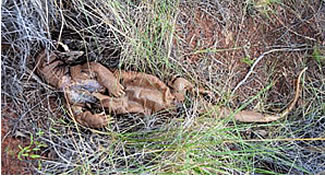 |
| commented. ”We started with doing a lot of toad busting around Kununurra and then we already couldn’t believe the numbers of toads we were catching. We got the opportunity to go to Nicholson Station to toad bust |
Figure 1. One of many dead Yellow Spotted monitors found in Marella within days of the toads arriving. |
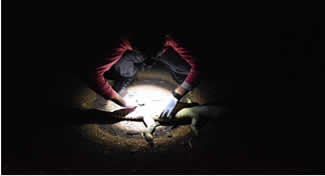 |
and help Jordy with the Marella research. This brought our experience with the Australian wildlife and bush to a whole new level”. Niamh continued “It is incredible to see what toads do with the native wildlife, and we have seen a lot of dead animals. While it was interesting to assist Jordy in the dissection of dead animals found in Marella Gorge, it was devastating to see just how toxic these toads were and that one toad was capable of killing quite large crocodiles and goanna’s”.
Figure 2. Crocodile dissection at night. Animal Scientist Jordy Groffen dissecting a dead crocodile found in Marella gorge |
Dutch ‘Beetle’ expert joins KTB
Andre Masseur, an amateur beetle expert and collector, joined KTB for two months, all the way from Holland, to identify the Nicholson Station beetle population, and to examine cane toad stomach contents for beetles. Andre 78 years young, bought 65 years of experience with him to assist KTB in the analysis of invertebrates at risk to the cane toad.
Andre is also co-author of the award winning book about beetles in France: “The Chrysomelinae (a subfamily of the Family of Leaf Beetles) of France” and “Les Coléoptères Buprestidae du Vaucluse - Inventaire et atlas (Col. Buprestidae)”. Because of his history with Australia Andre has always followed the news in Australia. When he heard about KTB research on invertebrates he immediately contacted KTB and volunteered his time and expertise. Andre has been amazed at the range and beauty of the beetle population on Nicholson. “It is amazing; the range and diversity. It is so great to find these beautiful creatures but sad to see how many of these small creatures make up the diet of the cane toad. My favoured beetle is the Jewel beetle and on my first day in the field on Nicholson Station I was able to record their presence”. |
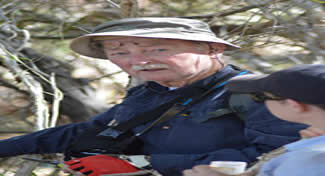
Figure 3. Andre Masseur looking for beetles at Marella gorge |
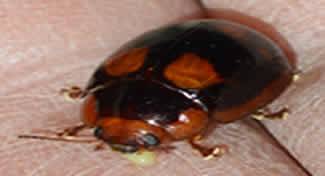 |
Andre has now recorded a number of Beetle species in Marella gorge and at the Nicholson Station homestead and is currently analysing the data. KTB will produce the results of this research in the next Newsletter. Andre’s preliminary analysis of the stomach contents of toads has indicated that a number of beetle species are under threat, including the Dung Beetle. Lee Scott-Virtue, President and founder of KTB stated. “We know from previous KTB research that cane toads have a serious impact on the critically important dung beetle populations in Australia, and this has been supported with Andre’s preliminary analysis. Because nothing is known about the effect of cane toads on other beetle’s species, Andre’s results are important”. Lee further commented. “Many invertebrate species, including the beetle species haven’t even been recorded. The research that Andre has been doing for KTB is really needed so we can at least analyse what we have before the toads arrive.” |
| Figure 4. one of the beetles: Paropsisterna beata |
Jordy Groffen, KTB Animal Scientist commented about the results of one toad stomach dissection. |
| “The potential impact on some beetle species became clear when we found 23 beetles, males and females, of the same species in one stomach”. He added. “It is not easy to see or identify invertebrates in stomach contents as they break down quickly but it is clear that each toad stomach we have dissected has a lot of beetles and shows the potential impact it has on beetle species and population. A single toad can eat up 200 food items a night and there are now ‘billions’ of cane toad eating our biodiversity ‘building blocks’. The only positive side to this is that toads are great collectors of invertebrate species, catching in one night more different species than we manage to collect in a week”.
Figure 5. An example of a stomach contents of one toad. Multiple lady bugs, ants and a water beetle that almost didn’t fitted in his stomach |
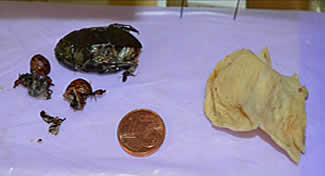 |
Turtle genetics
Two freshwater turtle species, the sandstone snake necked turtle (Chelodina burrungandjii) and the northern red-faced turtle (Emydura australis) are endemic to Australia and can only be found in the northern part of Australia. In the NT, the invasive cane toads are known to be a threat to some freshwater turtles (Dr. Nancy Fitzsimmons personal comment and observations by KTB). Surprisingly, toads can also have a positive effect on some turtle species due to the impact they have on their nest predators (Doody et al., 2006). In other turtle species such as the Northern long-necked turtle (Chelodina rugosa) it is shown, in a laboratory setting, that long-necked turtles can die after consuming cane toad eggs (Greenless and Shine, 2011). KTB have also recorded high numbers of deaths of the long-necked turtle when cane toads arrive.
KTB are now monitoring areas such as Marella Gorge on Nicholson Station to monitor and record the impact the cane toad’s arrival will have on the recorded numbers of freshwater turtles.
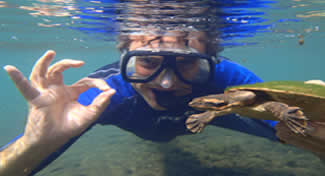 |
Turtle expert Dr. Nancy FitzSimmons of Griffith University, Queensland has been monitoring the freshwater turtle population in the Kimberley for 15 years and is preparing for the arrival of the cane toad into some of her research areas. Nancy has indicated that the long necked turtle appears to be a serious victim of the cane toad. Nancy has undertaken a comprehensive genetic study on the two freshwater turtle species recorded for the Kimberley. These two species have also been recorded in Marella Gorge, Nicholson Station. In collaboration with Dr. Nancy FitzSimmons, KTB Animal Scientist Jordy Groffen has taken samples of the sandstone snake necked turtle and northern red-faced turtle. Jordy commented. “The two freshwater species of interest were both present in the study area of Marella gorge and so we were very keen to be involved with such an interesting study”. Turtles were caught during snorkelling and with the help of turtle traps. Dr. Nancy FitzSimmons joined KTB in Marella for one of the last surveys and gave us some extra tips for catching turtles |
| Figure 6 Jordy Groffen, Animal Scientist of KTB with a Northern red faced turtle |
during snorkelling. |
Lee Scott-Virtue founder and President of KTB stated; ”It is so important to know what we have before the cane toads arrive, or else you will never know what the impact is if you don’t have the base line research done. This was the problem in Queensland and one of the reasons they have never really been able to determine the full impact of the cane toad. Whether turtles, crocodiles or beetles, every living thing has a part to play in creating a well balanced and healthy eco-system”.
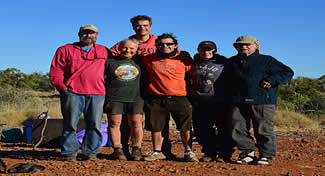 |
Figure 7. The crew in Marella gorge from left to right; Tony, Nancy FitzSimmons, Jordy Groffen (giant in the back row), Tiarnan Browne, Niamh Nolan and beetle expert Andre Masseur. |
 |
Minister Mark McGowan met with some of the Kimberley Toad Busters Board this year to reiterate his opposition Governments support of the Kimberley community and in their continuing efforts to mitigate the impact of cane toads on our native biodiversity. Mark participated in a toad bust with KTB in 2011 and is a Kimberley Toad Buster.
Figure 8. Minister Mark McGowan with Lee, Jordy, Ju Ju, Tiarnan and Niamh. |
Despite the lack of funding from the state government (no funding since July 2013) KTB’s continue to run their education and research programs. With the financial help of Greens MLC Minister Robin Chapple, KTB were able to produce 2,000 copies of their education brochure. 1,000 of these were sent to the Derby Land Care Group for a post office drop in an effort to help prepare Derby for the inevitable cane toad arrival. Lee Scott-Virtue and Dean Goodgame financed the Nicholson Station Marella Gorge program. Small donations from the public have assisted towards some of the fuel and vehicle costs.
KTB’s 2nd Year Visa program was also successfully run again during 2014, with 15 overseas people toad busting the Kununurra area over a period of 3 months. The Federal funding of $500,000 committed by the Federal Minister for Environment Greg Hunt towards the Kimberley Communities cane toad efforts is still in ‘limbo’ but KTB are hopeful that some of this funding will eventually reach the Kimberley Toad Busters.
Links to some of our Educational sites and DVD’s.
1. www.canetoads.com.au
2. Kimberley toad busters Facebook pages:
https://www.facebook.com/KimberleyToadBusters
https://www.facebook.com/pages/Kimberley-Toad-Busters-KTB/113247412075404?ref=hl
3.Kimberley Toad Busters going on a toad bust:
4.View the research documentary of the Kimberley Toad Busters (KTB):
5. View Dana Lyons "Cane toad muster" song composed for the Kimberley Toad Busters:
6. View Interview with Boonya Indigenous Elder from Derby:
7. View Interview with Kevin and William Indigenous Elders from Derby:
8. View Interview with JuJu Indigenous Elder from Kununurra:
9. View KTB Chronological history from 2004 - 2013-11-02
Donate to the Kimberley Toadbusterss
Reference cited
Doody, J. S., Green, B., Sims, R., Rhind, D., West, P., Steer, D. 2006. Indirect impacts of invasive cane toads (Bufo marinus) on nest predation in pig-nosed turtles (Carettochelys insculpta). Wildlife Research, 2006, 33, 349–354
Greenless, M. J. and Shine, R. 2011. Impacts of eggs and tadpoles of the invasive cane toad’s(Bufo marinus) on aquatic predators in tropical Australia. Austral Ecology; 36, 53–58
Don’t forget to “Like” us on Facebook and Follow us on Twitter!
For further information contact
Lee Scott-Virtue: 08 91687080
If everyone became a toad buster.
The toads would be busted!

Kimberley Toad Busters awards!
For more information on any of the articles contact:
Lee Scott-Virtue: KTB Founder & President 08 9168 7080 kimberleytoadbusters@canetoads.com.au
All donations are tax deductible.
Sponsors


|





